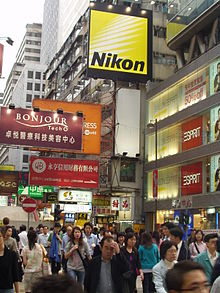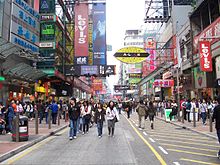- Mong Kok
-
For other uses, see Mong Kok (disambiguation).
Mong Kok Sai Yeung Choi Street South in Mong Kok Chinese 旺角 Literal meaning flourishing/busy corner Transcriptions Mandarin - Hanyu Pinyin Wàngjiǎo - Wade–Giles wang4 chiao3 Cantonese (Yue) - Jyutping Wong6 Gok3 - IPA [wɔ̀ːŋ kɔ̄ːk] Mong Kok (also spelt Mongkok), less often known as Argyle (see Name section), is an area in the Yau Tsim Mong District on Kowloon Peninsula, Hong Kong. Before the 1994 merger, Mong Kok was part of the Mong Kok District.
The district is characterized by a mixture of old and new multi-story buildings, with shops and restaurants at street level and commercial or residential units above. Major industries in Mong Kok are retail, restaurants (including fast food) and entertainment.
Mong Kok's population density is extremely high. According to Guinness World Records, Mong Kok has the highest population density in the world (mean 130,000 per km2 or 340,000 per mi2) and with a development multiple of four.
Contents
Name
The current English name is a transliteration of its older Chinese name 望角 (or 芒角), which is pronounced "Mong Gok" and is named after its plentiful supply of ferns in the past when it was a coastal region. Its present Chinese name "旺角" is pronounced "Wong Gok". The name in Chinese means "prosperous corner".
The area was also called Argyle in English for some time in the past. This name was used for the MTR station in the area, when it was opened in 1979. Also, the office building 旺角中心, which was named after the area, is known in English as Argyle Centre instead of Mong Kok Centre.
History
Displays at the Chinese University of Hong Kong show some antique potteries, indicating that there might be settlements that early as Jin Dynasty (265-420).[1]
The area of Mong Kok has changed significantly over the years. The heart of the present-day Mong Kok was Ho Man Tin whilst the proper Mong Kok was north of it, near present-day Mong Kok East Station of MTR. With cultivated lands, it was bounded south by Argyle Street, west by Coronation Road (present-day Nathan Road), and east by the hills. To its south is Ho Man Tin and west Tai Kok Tsui. Stream from the hills east offered water for cultivation.
On 10 August 2008 the Cornwall Court fire broke out. More than 200 firefighters were involved in the rescue operation. Four people died, including two fire fighters.[2]
Mong Kok got a lot of negative media attention when it was hit by a number of acid attacks on Sai Yeung Choi Street from December 2008 through January 2010.
Streets and markets
 Argyle Street in Mong Kok
Argyle Street in Mong Kok
Mong Kok preserves its traditional characteristics with an array of markets, small shops, and food stalls that have already disappeared from other areas in Hong Kong over the past several decades of economic developments. As such, a few of these streets in Mong Kok have acquired interesting nicknames reflecting their own characteristics. Some interesting sites are:
- Ladies' Street (女人街, Ladies' market on Tung Choi Street) - This market specializes in women's clothing, accessories, cosmetics, and the like. It is open daily from noon to 00.00 a.m. at Tung Choi Street on the east of Nathan Road. Typically, where there is a market, there are also food stalls selling noodles, seafood, and congee for mid-afternoon or late-night snacks. A grocery market is also located in the vicinity, convenient for consumers searching from a diverse range of items; ranging from vegetables to clothing.
- Sai Yeung Choi Street South, (西洋菜南街) - A street full of shops selling consumer electronic products, comestics, and discount books, the last of which are usually located on the lower floors above ground floor of buildings.
- Temple Street (廟街, sometimes referred to as Men's Street), extending into Jordan, is also in the area, however, the area famous for the Hong Kong specific goods are only in the section between Yau Ma Tei and Jordan.
- Yuen Po Street Bird Garden (園圃街雀鳥花園) - Hundreds of songbirds in exquisitely crafted cages can be seen at this market, which is on the other side of Nathan Road on Yuen Po Street. The garden is open from 10 a.m. to 6 p.m. It is close to Mong Kok East MTR Station and Mong Kok Stadium. Packed with booths selling birds, Hong Lok Street (Bird Street, 雀仔街) was closed as part of an urban renewal project in June 1998. The Garden was constructed by the government to accommodate some of the booths. It was completed in March 1997.[3]
- Fa Yuen Street (花園街, sometimes referred to as 波鞋街, which means Sneakers Street) - This is a small neighbourhood with many small retailers which sell sports equipment and clothing. It has a wide diversity of sports shoes, including many shoes of rare or special editions from different places.
- Flower Market Road (花墟道) - This is a street market near the Mong Kok East MTR Station with lots of flower shops and street hawkers showing colourful displays, the sweet scents and the exotic blossoms of many houseplants.
- Goldfish Market - There are a dozens of shops and hawkers selling various tropical freshwater or marine fish near the MTR train station. Different types of aquarium equipment can also be found there. This market opens very early in the morning.
- Tile Street - This is a section of Portland Street near Argyle Street and Bute Street with more than 50 retailers selling materials for construction or renovation, such as tiles, wall paper, window frames and bath tubs.
- Photocopy Street (影印街) - A neighbourhood near Ho Man Tin is noted for having remarkable number of photocopying shops due to the number of schools in the vicinity. The students from those schools have creates a great demand for photocopying, mostly for copyrighted textbooks and class handout, in mass quantity.
- Portland Street (砵蘭街) - The best-known de facto red-light district in Hong Kong.
- Dundas Street (登打士街) marks the southern boundary of the shopping area in eastern Mong Kok. Ho King Shopping Centre, Ka Lok Shopping Arcade and Trendy Zone are major shopping centres on the street. Various kinds of food shops concentrate on this street. Dundas street joins with the shopping area of Sai Yeung Choi Street South, Tung Choi Street and Fa Yuen Street; Kwong Wah Hospital is also situated on the street. Across Nathan Road, the section in the western Mong Kok is relative quiet and there are many cafés above street level in several buildings.
Some popular shopping plazas are located in this dense area, including:
- Sino Centre (信和中心) – In this plaza, there are many products about Japanese cartoons, such as Video CDs, DVDs, and comics. Beside that, there are shops selling music CD albums, including ones by Hong Kong, Japanese, and western pop singers. The centre also hosts several Japanese style karaoke booths which can be booked by the hour.
- Ho King Shopping Centre (好景商場)- In this plaza, you can find many products having to do with computer and video games. They are sold for relatively low prices compared with other shops. The fourth floor of the plaza is infamous for being formerly the biggest base of pornographic CDs and DVDs. These have recently been diminished in a large operation by the police and customs, although this action has driven some shops to the office section of the building, with the products and customers causing distress to female workers there.
- Grand Century Place (新世紀廣場) - This is a new plaza next to the Mong Kok East MTR station. Most of the famous-brand and popular shops can be found here.
- Mong Kok Computer Centre (旺角電腦中心 )- This three-story computer mall has around 50 to 70 computer shops. They sell various kinds of products including laptops, software, hardware and computer accessories.
- Langham Place (朗豪坊) - This shopping mall/hotel/office complex opened in 2004 in central Mong Kok. Built according to the Hong Kong Government urban redevelopment scheme, and at 59 stories high, it is the tallest landmark in Mong Kok.
- Argyle Centre (旺角中心) - This usually crowded centre, located next to the Mong Kok MTR station, has three floors of shops selling low-priced clothes and shoes, plastic toys and heavy metal CD's.
Food
The Mong Kok area has many curb-side "food-booths". Most of them sell traditional snacks such as fish balls, fried beancurd (tofu) and various dim sum. These snacks and "fingerfood" are very popular in Hong Kong, especially for folks on the run.
Many different kinds of cuisines, Japanese, Chinese, Italian, and Thai food, can be found in the area.
Transport
Exit B1 of Prince Edward Station, with Exit C1 across Prince Edward Road West.
- Part of Nathan Road is in this area.
- Four rail lines serve the district.
- The MTR Tsuen Wan and Kwun Tong lines have two interchanges in this area: Prince Edward Station to the north and Mong Kok Station to the south.
- The Tung Chung Line of MTR has a through station west of the area in Tai Kok Tsui, named Olympic.
- MTR East Rail Line also has a Mong Kok East Station in the eastern part of the area.
In popular culture
Mong Kok was the setting for the 2004 hit film One Night in Mongkok directed by Derek Yee. The movie portrays Mong Kok, one of the most densely populated places on Earth, as a hotbed of illicit activity. Similarly, the district was also the setting of the 1996 film Mongkok Story (旺角風雲) directed by Wilson Yip which depicts a young man who becomes involved in a Triad gang.[4][5] The literal Chinese title of the 1988 film As Tears Go By by Wong Kar-wai is "Mong Kok Carmen". Part of Robert Ludlum's The Bourne Supremacy was set in Mong Kok.
See also
- Nos. 600-626 Shanghai Street, a group of tong-lau listed as Grade I historical buildings
References
- ^ Kan, Nelson Y. Y. and Tanf, Miranda K. L. New Journey Through History 1A. Published by Aristo Educational Press LTD. Chapter two, P.48.
- ^ Yahoo. "Yahoo.com." Four dead as HK nightclub fire spreads. Retrieved on 28 August 2008.
- ^ Leisure and Cultural Services Department - Yuen Po Street Bird Garden: Introduction
- ^ IMDB. "IMDB.com." Wong Gok fung wan. Retrieved on 28 August 2008.
- ^ Yahoo.com. "Movies.yahoo.com." Mongkok story. Retrieved on 28 August 2008.
External links
Categories:- Mong Kok
- World records
Wikimedia Foundation. 2010.









